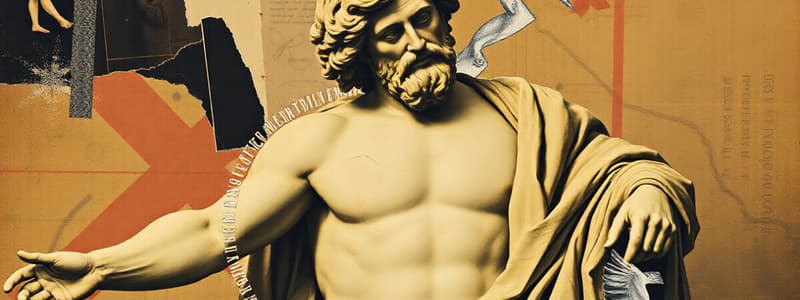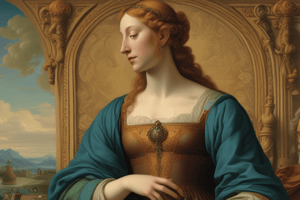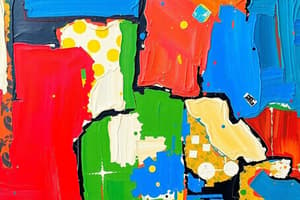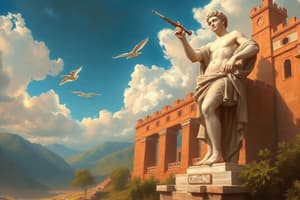Podcast
Questions and Answers
What does the term 'Baroque' derive from?
What does the term 'Baroque' derive from?
- The word 'Barocco' (correct)
- A style of painting
- A type of sculpture
- A form of architecture
Which artist is known as the first Baroque artist?
Which artist is known as the first Baroque artist?
- Michelangelo
- Caravaggio
- Rubens
- Bernini (correct)
What is a characteristic feature of Renaissance art?
What is a characteristic feature of Renaissance art?
- Emphasis on exaggerated motion
- Complexity and chaos
- Calm and beauty (correct)
- Focus on religious themes only
What notable artwork was created by Caravaggio?
What notable artwork was created by Caravaggio?
Which aspect defines Baroque art compared to Renaissance art?
Which aspect defines Baroque art compared to Renaissance art?
What is the title of Bernini's greatest achievement?
What is the title of Bernini's greatest achievement?
How did Caravaggio's painting style differ from classical masters?
How did Caravaggio's painting style differ from classical masters?
In which city did Baroque art initially begin to develop?
In which city did Baroque art initially begin to develop?
What does the term 'Renaissance' mean?
What does the term 'Renaissance' mean?
Which characteristic is NOT associated with Renaissance art?
Which characteristic is NOT associated with Renaissance art?
Who is often referred to as the ultimate 'Renaissance man'?
Who is often referred to as the ultimate 'Renaissance man'?
Which of the following is one of Michelangelo's famous sculptures?
Which of the following is one of Michelangelo's famous sculptures?
What significant change did the Renaissance bring to European art?
What significant change did the Renaissance bring to European art?
In which century did the Italian Renaissance begin?
In which century did the Italian Renaissance begin?
What aspect of architecture is emphasized during the Renaissance?
What aspect of architecture is emphasized during the Renaissance?
Which artist created the sculpture 'David'?
Which artist created the sculpture 'David'?
Which artist is known for the painting 'Samson and Delilah'?
Which artist is known for the painting 'Samson and Delilah'?
What is a key characteristic of Rembrandt's approach to painting?
What is a key characteristic of Rembrandt's approach to painting?
Who is depicted in the painting 'Helena Fourment with a carriage'?
Who is depicted in the painting 'Helena Fourment with a carriage'?
Which of the following works was created by Diego Velasquez?
Which of the following works was created by Diego Velasquez?
What was a primary focus of Peter Paul Rubens' commissioned works?
What was a primary focus of Peter Paul Rubens' commissioned works?
What technique does Rembrandt use in his self-portrait to convey aging?
What technique does Rembrandt use in his self-portrait to convey aging?
What significant event is depicted in Caravaggio's painting 'Conversion of St. Paul'?
What significant event is depicted in Caravaggio's painting 'Conversion of St. Paul'?
What is a defining feature of Baroque art compared to Renaissance art?
What is a defining feature of Baroque art compared to Renaissance art?
What technique did Rembrandt develop throughout his artistic career?
What technique did Rembrandt develop throughout his artistic career?
In 'Las Meninas', who is the central figure?
In 'Las Meninas', who is the central figure?
What aspect of viewing does Baroque art aim to achieve?
What aspect of viewing does Baroque art aim to achieve?
What aspect of his career did Velasquez discover early on?
What aspect of his career did Velasquez discover early on?
Which item is NOT mentioned as present in 'Las Meninas'?
Which item is NOT mentioned as present in 'Las Meninas'?
What is the main theme of the sculpture 'Ecstasy of St. Teresa' by Bernini?
What is the main theme of the sculpture 'Ecstasy of St. Teresa' by Bernini?
Which of the following best characterizes the Baroque Period?
Which of the following best characterizes the Baroque Period?
What is suggested about the portrayal of emotions in Baroque art?
What is suggested about the portrayal of emotions in Baroque art?
Which of the following paintings is considered the most reproduced religious painting of all time?
Which of the following paintings is considered the most reproduced religious painting of all time?
What is the primary artistic style associated with Raphael's works?
What is the primary artistic style associated with Raphael's works?
Which artwork is known as Raphael's most famous and was his last painting before his death?
Which artwork is known as Raphael's most famous and was his last painting before his death?
What medium was Donatello NOT known to use in his sculptures?
What medium was Donatello NOT known to use in his sculptures?
What is notable about Michelangelo's approach to the subject in his work 'Pieta'?
What is notable about Michelangelo's approach to the subject in his work 'Pieta'?
Who commissioned the portrait known as 'Mona Lisa'?
Who commissioned the portrait known as 'Mona Lisa'?
What characterizes the statue 'David' created by Donatello?
What characterizes the statue 'David' created by Donatello?
Which of the following works was NOT created by Raphael?
Which of the following works was NOT created by Raphael?
Flashcards
Renaissance Period
Renaissance Period
A period of rebirth, revival, or new beginning in Europe (1400-1600), marked by economic progress and renewed interest in ancient philosophy and art.
Italian Renaissance
Italian Renaissance
The beginning of the Renaissance in the late 14th century in Italy, emphasizing humanistic and realistic art.
Renaissance Art
Renaissance Art
Art characterized by accurate anatomy, scientific perspective, and deeper landscapes, showcasing a shift from medieval to modern Europe.
Michelangelo
Michelangelo
Signup and view all the flashcards
Leonardo da Vinci
Leonardo da Vinci
Signup and view all the flashcards
Renaissance Architecture
Renaissance Architecture
Signup and view all the flashcards
Renaissance Humanism
Renaissance Humanism
Signup and view all the flashcards
Secular Art
Secular Art
Signup and view all the flashcards
Raphael's famous works
Raphael's famous works
Signup and view all the flashcards
Donatello's contribution
Donatello's contribution
Signup and view all the flashcards
Michelangelo's Pieta
Michelangelo's Pieta
Signup and view all the flashcards
Leonardo da Vinci's Mona Lisa
Leonardo da Vinci's Mona Lisa
Signup and view all the flashcards
High Renaissance art
High Renaissance art
Signup and view all the flashcards
Donatello's David
Donatello's David
Signup and view all the flashcards
Raphael's The Transfiguration
Raphael's The Transfiguration
Signup and view all the flashcards
Baroque Art
Baroque Art
Signup and view all the flashcards
What does 'Baroque' mean?
What does 'Baroque' mean?
Signup and view all the flashcards
Caravaggio
Caravaggio
Signup and view all the flashcards
Gian Lorenzo Bernini
Gian Lorenzo Bernini
Signup and view all the flashcards
Ecstasy of St. Teresa
Ecstasy of St. Teresa
Signup and view all the flashcards
Piazza San Pietro
Piazza San Pietro
Signup and view all the flashcards
Rubens
Rubens
Signup and view all the flashcards
What distinguishes Baroque art from Renaissance art?
What distinguishes Baroque art from Renaissance art?
Signup and view all the flashcards
Peter Paul Rubens's specialty
Peter Paul Rubens's specialty
Signup and view all the flashcards
Peter Paul Rubens's commissions
Peter Paul Rubens's commissions
Signup and view all the flashcards
Rembrandt's style
Rembrandt's style
Signup and view all the flashcards
Rembrandt's self-portraits
Rembrandt's self-portraits
Signup and view all the flashcards
Diego Velasquez's style
Diego Velasquez's style
Signup and view all the flashcards
Caravaggio's 'Conversion of St. Paul'
Caravaggio's 'Conversion of St. Paul'
Signup and view all the flashcards
Bernini's 'Ecstasy of St. Teresa'
Bernini's 'Ecstasy of St. Teresa'
Signup and view all the flashcards
Why is St. Teresa's heart pierced?
Why is St. Teresa's heart pierced?
Signup and view all the flashcards
Baroque Art vs. Renaissance Art
Baroque Art vs. Renaissance Art
Signup and view all the flashcards
Las Meninas
Las Meninas
Signup and view all the flashcards
Rubens' Portraits
Rubens' Portraits
Signup and view all the flashcards
Infanta Margarita Teresa
Infanta Margarita Teresa
Signup and view all the flashcards
Role of Dwarfs in Art
Role of Dwarfs in Art
Signup and view all the flashcards
Art and Emotion
Art and Emotion
Signup and view all the flashcards
Study Notes
Renaissance Art
- The term "Renaissance" originated from the Latin word "Rinascere," meaning rebirth, revival, or a new beginning.
- The Renaissance period (1400-1600) saw economic progress and renewed enthusiasm for ancient philosophy and artistic values.
- Italian Renaissance art (late 14th century) marked a new era of artistic and intellectual achievement, focusing on realistic and humanistic art.
- Characteristics include accurate anatomy, scientific perspective, and deeper analysis.
- The Renaissance represented a transition from the Medieval period to the Early Modern age, developing in parallel with Late Medieval art.
- This transition became evident across parts of Europe by 1500, when the Renaissance style prevailed.
- The period brought a portrayal of the human figures, like in Greek art.
Famous Renaissance Artists and Works
- Michelangelo di Lodovico Buonarroti (sculptor, painter, architect): known as one of the greatest artists of all time.
- Notable works include Pieta, Bacchus, Moses, David, Dying Slave, Dawn, and Dusk ; The Pieta and David.
- Leonardo di ser Piero Da Vinci (painter, architect, scientist, mathematician): considered the ultimate "Renaissance man."
- Significant works include The Last Supper and the Mona Lisa.
- Raffaello Sanzio da Urbino (painter and architect): renowned for clarity of form, easy composition, and visual achievement of the Neoplatonic ideal.
- Famous works include the Sistine Madonna, The School of Athens, and The Transfiguration.
- Donato di Niccolò di Betto Bardi (Donatello): an early Renaissance Italian sculptor from Florence, and revolutionized sculpture.
- Notable works include David, Statue of St. George, Equestrian Monument of Gattamelata, Prophet Habacuc, and The Feast of Herod.
Baroque Art (1600-1800)
- The term "Baroque" was derived from the word "Barocco," meaning "Irregularly shaped pearl or stone."
- Baroque art focused on painting, sculpture, and architecture.
- It was a period of exaggerated motion, drama, tension, and grandeur.
- The style originated in Rome, Italy, and spread across Europe.
Famous Baroque Artists and Works
- Michelangelo Merisi or Amerighi da Caravaggio (painter): an Italian artist who wanted to deviate from classical Renaissance masters, known for religious and still life paintings.
- Key works include Supper at Emmaus, Conversion of St. Paul, and Entombment of Christ.
- Gian Lorenzo Bernini (artist): the first Baroque artist and mastered architecture, sculpture, painting, stage design, and playwriting.
- A notable example of his work is the Piazza San Pietro in front the Basilica.
- Peter Paul Rubens (painter): a Flemish Baroque painter known for mythical, figurative subjects, landscapes, portraits, and Counter-Reformation altarpieces.
- Examples of his work are religious subjects, history paintings, magical creatures, and hunt scenes.
- Rembrandt Harmenszoon van Rijn (painter and etcher): a celebrated Dutch realist who painted and etched, excelling in the European art scene.
- His works often included religious subjects.
- Diego Velázquez (painter): a master of composition, playing a vital part in the Spanish Golden Age, known for his passion for still life works.
- Works like the Surrender of Breda, Las Meninas (The Maids of Honour), Los Barachos (The Drinker), and Maria Theresa.
Additional Information on Art Processes
- Baroque art aimed to create a powerful and unforgettable impact on viewers, evoking strong emotions such as excitement, ecstasy, and intoxication.
- The Baroque period directly followed the Renaissance in art history.
- Baroque artists prioritized mass and movement in their works, often using exaggeration in forms, gestures, and emotions.
Studying That Suits You
Use AI to generate personalized quizzes and flashcards to suit your learning preferences.




